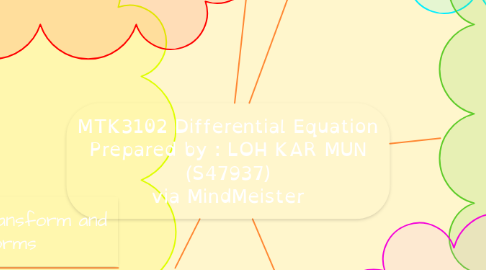
1. The Laplace Transform and Inverse Transforms
1.1. The Transform Concept
1.1.1. K(s,t) is called the kernel of the transformation.
1.2. Definition of Laplace Transform
1.2.1. The Laplace transform of F(t) is denoted by L{F(t)} = f(s) where f(s) is a function of parameter s.
1.2.2. Operator L is a linear operator.
1.2.3. when s>k, it is converge, where k=constant. Otherwise, it is diverge.
1.3. Transforms of Elementary Functions
1.3.1. Use integration by parts to solve the integral.
1.4. Transform of Derivatives
1.4.1. If F(t) is continuous for t≥0 and is also of the exponential order as t→∞, and if F'(t) is of class A, then L{F'(t)}=sL{F(t)}-F(0).
1.5. Definition of an Inverse Transform
1.5.1. F(t)=L^(-1) {f(t)}
1.6. Partial Fractions
1.6.1. Steps: 1. Find the distinct linear factors of denominator. 2. Constants A,B,C.. exist as numerators with the factors. 3. Multiplying each term by lowest common denominator to obtain the identity. 4. Find the constants A,B,C... by substitute the roots of the factors and compare the coefficients with the numerator of the equation given.
1.7. Initial Value Problems
1.7.1. Applied if the appropriate initial conditions are given along with the differential equations.
2. Linear Systems of Equations
2.1. First-order Systems with Constant Coefficients
2.1.1. Write the linear equations of order higher than one in terms of a first-order system by creating new variables.
2.2. Some Matrix Algebra
2.2.1. X' = AX : a system of first-order linear equations with constant coefficients.
2.2.2. X'-AX=0 where X and 0 must in 3-dimensional column vector (followed the given column vector)
2.2.3. AX=0 has nontrivial solutions, that is X≠0 if and only if the determinant of A=0.
2.3. Solution of a First-order System
2.3.1. Characteristic equation of matrix A, |A-mI|=0. Its roots are called eigenvalues of matrix A. The solution of equation for eigenvalue is called an eigenvector.
2.4. Complex Eigenvalues
2.4.1. The eigenvalues occur in conjugate pairs and its eigenvectors are also conjugates of one another.
2.5. Repeated Eigenvalues
2.5.1. Two linearly independent solutions are needed to form general solution. However, there has only one eigenvalues. From our experiences of repeated roots, we able to find the second roots by simply adding t into one of the solution.
3. Equations of order one
3.1. Separation of Variables
3.1.1. Mdx + Ndy = 0
3.1.1.1. A(x)dx + B(y)dy = 0
3.2. Homogeneous Functions
3.2.1. The function is homogeneous if it is multiplied by some factor.
3.3. Equations with Homogeneous Coefficients
3.3.1. Way to solve : 1. Ensure that the functions is homogeneous. 2. introduce a new variable v by letting y=vx or x=vy. 3. Find the solution using suitable method, eg separation of variables, 4. Substitute the original variables.,
3.4. Exact Equations
3.4.1. If the equation Mdx + Ndy = 0 is exact, then dF = Mdx + Ndy
3.4.1.1. dF=(∂F/∂x) dx+ (∂F/∂y) dy , where M=(∂F/∂x) and N=(∂F/∂y)
3.4.2. If ∂M/∂y=∂N/∂x , then it is an exact equation.
3.5. The Linear Equation of Order One
3.5.1. Steps to solve : 1. Write the equation in standard form 2. Obtain the integrating factor exp(∫P dx) 3. Multiply both sides of the equation by the integrating factor. 4. Solve the resultant equation.
4. Linear Differential Equations
4.1. General Solution of a Nonhomogeneous Equation
4.1.1. General solution is the sum of the complementary function and any particular function.
4.2. The General Linear Equation
4.2.1. Any linear combination of solutions of a homogeneous linear differential equation is also a solution.
4.3. Differential Operators
4.3.1. D denoted differentiation with respect to x
4.3.2. the product of AB : ABy=A(By)
4.3.3. For operators with constant coefficients, it is true that AB=BA
4.4. Auxiliary equations
4.4.1. Distinct Roots
4.4.1.1. Solution : y=exp(mx)
4.4.2. Repeated Roots
4.4.2.1. Solution : c_n x^(n-1) e^bx
4.4.3. Imaginary Roots
4.4.3.1. conjugate imaginary roots
5. Non-homogeneous Equation and Variation of Parameters
5.1. The Method of Undetermined Coefficient
5.1.1. Applicable when and only when the right-hand-side member of the equation is itself a particular solution of some homogeneous linear differential equation with constant coefficients.
5.2. Reduction of Order
5.2.1. Applicable to linear with variable coefficients. This method is also not restricted to equations with constant coefficients.
5.2.2. This method depends much on integrations ie. integrating factor.
5.3. Variation of Parameters
5.3.1. Involving two unknown functions, A(x) and B(x)
